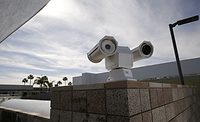The Customer Is Always Right! Right?
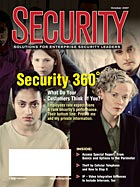

Terry Denison at the town of Parker, Colo., helped pick a security solution for its new 100,000 square foot recreation center. Staff and public safety officers expected to monitor the multi-million dollar facility from on- and off-site locations while customers of the rec center expected the heightened sense of security.
Sure, they share a commitment to their organization’s business and security missions. But their focus also is on customer service, whether their customers are internal employees, diverse tenants, students and parents, shoppers or, more broadly, citizens and government agencies.
Having customer support and understanding of the security effort is growingly important, as important for some operations as support from the CEO. According to new research from Maddry Associates, most customers expect security to protect themselves, protect their personal and business-confidential information as well as help enforce ethics, guarantee business continuity and work more smoothly with other departments in the organization.
But, while customers, especially employees, rank their ease of handling physical and computer protections as important, many do not rate the policies, procedures and systems provided as easy to use or effective. The biggest specific letdown in the minds of customers is the security provided in parking lots and garages.
See a summary chart of the research elsewhere in this article. Results are based on a one-on-one “clipboard” survey of 300 employees (not C-level or security management) at 30 business and government locations. Managed by Maddry Associates, which used student volunteers standing in front of facilities, the volunteers verbally asked questions and wrote down answers. Conducted June 2007, all respondents were assured confidentiality.
Areas of expectation and ranking mostly mirrored a May 2007 Security Magazine survey of what CEOs thought of their security operation.
The bottom line: Chief security officers, security directors and executives with security responsibility do a better job in the eyes of their customers when they focus on their customer’s personally-held concerns and needs, and that leads to positive fallout when it comes to support for top management.
Skip Elliott knows.
Following 9/11, CSX, one of the four largest railroads in the United States, was faced with a challenge: In a customer service sense, how to protect the communities through which it operates and the assets so important to the critical service it provides in an efficient and cost effective manner?
“We have always been concerned about safety and security, but after the tragedy of 9/11, we knew immediately that we were operating in a new environment,” says Skip Elliott, vice president of public safety and environment for CSX Transportation, Jacksonville, Fla. “As a major freight transportation company, we touch thousands of communities and operate and maintain key facilities and structures in many of them. We needed to adjust quickly and make sure that we were protecting them properly – really the same challenge that confronted so much of America at that time.” CSXT’s vast infrastructure includes bridges, tunnels, fuel sites and data centers. “But,” said Elliott, “our first concern was, and remains, protecting the public and our employees. In order to do that, we must do an effective job of protecting our facilities, too.”
One of the first assets CSXT looked at was its Virginia Avenue tunnel, which runs underneath the heart of Washington, D.C. “While we immediately put guards at both ends of the tunnel, we also began researching ways to use technology to provide more comprehensive coverage.”
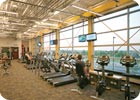
Certain areas of the Parker, Colo., Fieldhouse have state-of-art security as well as monitoring at the reception desk and on-site monitoring at the town’s offices and potential by law enforcement.
A WORKABLE SOLUTION
CSX needed a security company that would understand the unique environment and needs of a freight rail company. “It’s very dynamic,” Elliott said. “It’s not a simple fixed facility. It makes some of the solutions a little bit more difficult to come up with.”Duos Technologies, Inc., also of Jacksonville, was one of the companies CSX considered.
“They had been doing some work in our rail yards,” Elliott explained. “They had a greater understanding what the railroad is, how it works, and the day-to-day challenges we face. With their technology, the translation from that application to the communities where we operate and our critical facilities located there was a natural extension. We found we already had someone out there doing something we were interested in doing.”
That “something” was using camera and intrusion systems and automating the process so it didn’t rely on one person watching. “We wanted surveillance technology that would trigger an alarm if an intruder were detected.” Elliott said, explaining the customer focus of the project.
Said Gianni Arcaini of Duos Technologies, “As we were looking for customers that would be interested in our automation and engineered services, we got a call from CSX. We felt we could help them secure the Virginia Avenue tunnel quite well, and we got the opportunity to build that system in early 2003.”
The resulting system works as CSX hoped it would.
“What it really does is imagine a rail line and create a virtual fence around this security asset,” Elliott said. “We have this array of cameras. The fence line is created by identifying pixels on the camera screen.
“We monitor this at our 24/7 public safety coordination center. If someone enters that area there is an audible alarm and a recording in multiple languages that tells the intruder they are in a restricted area. At the same time, we mobilize and take specific steps to stop that person from getting closer.”
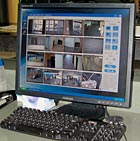
THE WASHINGTON CORRIDOR PROJECT
Once the system was up and running successfully, there was an expansion of the customer service focus when it drew the attention of the Department of Homeland Security (DHS), a unique customer.“DHS expressed an interest in coming up with a more robust set of security measures for our freight line that ran North/South through the heart of Washington D.C.,” Elliott explained. “They were very interested in the technology we had applied at the Virginia Avenue tunnel that we had developed with Duos.”
In the meantime, Duos had continued to expand on its offerings, and was now focusing on video analytics. “At the time, we made the decision to move from analog system architecture to digital, using intelligent video,” Arcaini said. “We decided to develop our own intelligent video from scratch. We didn’t want to sell a canned product. We recognized from an engineering standpoint that there is no such thing as one software solution fixes everything. Every project is different.”
DHS, after much review, saw this as a solution to help provide security for a longer portion of the D.C. Corridor. The resulting project, known as the Washington D.C. Rail Security Corridor, features a $9.8 million DHS-financed budget and is currently in the installation process.
The project incorporates seven miles of track stretching from Reagan National Airport across the Anacostia Bridge, including the original Virginia Avenue tunnel countermeasures, which will be upgraded with the newer analytics package.
When the system is complete, CSX will be in charge of monitoring it, but other agencies will have concurrent access to the information. More customers will be added to serve. “We will continue to build on our strong relationship with law enforcement in that area. And we have very specific plans on how we are going to respond to events,” Elliott said.
He added that the chief advantage to the new system will be the heightened ability to know friend from foe.
At the Virginia Avenue tunnel, for example, the new features will include radio frequency identification (RFID) capability, along with the video analytics. “We have employees routinely working in this area. Through RFID we will be able to sort out the people that belong and those who don’t. We will still get a notification, but we will recognize whether that person belongs in the area.”
Another customer service boost for other areas of the corridor is the video analytics’ “left devices” capability, which will trigger an alarm if anyone leaves a bag, package or other item that doesn’t belong.
“There are commuter and passenger trains on our lines, Elliott observed. “We work closely with those agencies, and this system will help them in their security missions.” Elliott expects the first part of the new system to be up and running this month.

MOVING FORWARD
“I think this corridor concept has merit in other cities besides Washington D.C.,” Elliott says. “DHS has identified 46 urban areas with freight lines that go through the city. CSX operates in 26 of those. As DHS regulates the railroad more and identifies more high-risk areas, it will help us move forward with this technology.”Elliott is pleased to be working with DHS on this project and future ones. “I give credit to DHS for working with us on the project. I think we are all going to learn a lot.”
And in the end, a secure system is what ultimately matters, he added.
“We are just trying to do the right thing to provide greater security in conjunction with the government agencies. We understand our responsibility to do our part to enhance homeland security, and we take that responsibility very seriously.”
Michael May has an equally strong customer focus in an equally vulnerable area – Manhattan and the Tri-states area. May, executive vice president with George Comfort & Sons, one of New York’s oldest and most reputable commercial real estate firms, knows the importance of customer satisfaction and service when it comes to building and personal security. It manages about ten million square feet of commercial property, half owned by May’s firm.
“Security concerns go hand in hand. Our concerns are our tenants’ concerns,” said May. For him, the key to the best customer service when it comes to security is “constant communications with my tenants, frequency discussions.” May balances security officers with electronic security. “One complements the other. Providing security is “a fluid process. You have to change with changing needs.”
The real estate executive receives security expertise and support from his service provider, Classic Security, which works under the umbrella of Alliance Building Services. According to David Reiss, Classic’s senior vice president, the firm employs about 800 security officers but there’s also a tech division that can provide turnstiles, security video, covert cameras and access controls.
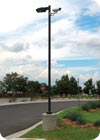
Meeting the expectations of its customers, the new fieldhouse’s parking lots have visible security gear including pole-mounted cameras.
OFFICERS ON FRONT LINE FOR CUSTOMERS
Among May’s customers, one expectation – beyond electronic security systems – is a visible and professional officer force.“Customers have come to expect a better rounded security officer, continuously training with emphasis on customer service. May’s officers must be a solid customer resource for directing traffic with the ability to answer diverse questions,” said Reiss.
Both May and Reiss are handling New York City’s Local Law 26, which centers on life safety in times of emergencies at high rise buildings. New York City’s Local Law 26 now requires all commercial office properties to develop emergency action plans for responding to non-fire events such as:
- Terrorist attacks
- Biological incidents
- Chemical incidents
- Nuclear incidents
- Civil disturbance and other natural and man made disasters
Proper implement of a program for 26 compliance has given customers of George Comfort & Sons an expectation that security and life safety are taken care of.
Which is a goal shared by Terry Denison, systems analyst for the town of Parker, Colo., who helped pick a security video solution for its new 100,000 square foot recreation center, allowing staff and public safety officers to monitor the multi-million dollar facility from on- and off-site locations. Customers of the rec center expect and appreciate the heightened security.
“My customers expect to be able to come to a facility that is well run, where it is safe for them and their children. It’s recreation, not worries. That’s the primary security consideration,” said Denison.
That’s also why cameras are visible to patrons and there’s a monitoring station at the front desk where families show their ID cards.
The town called on CDW-G for advice on the solution that would best meet the security requirements for the Parker Fieldhouse, which includes a gymnasium with two regulation-size hardwood basketball and volleyball courts, an in-line hockey rink with seating for 200 spectators, an artificial turf field with spectator seating, a rock-climbing tower, a suspended running track, a fitness area and batting cages.

Derrick Chen worked with Ellen Leviss, director of administration at Amster, Rothstein & Ebenstein, a New York City law firm, so she could better serve her internal customers more accurate information more quickly about a steam pipe incident in New York City.
SAFELY USING THE FIELDHOUSE
With thousands of young people and adults expected to use the facility weekly for team sports and other activities, and just two to three staff on duty at any time, the town needed a technology solution that would easily enable staff to monitor the sprawling facility. The town selected 18 motion-activated Axis Communications cameras that are positioned inside and outside the fieldhouse, providing around-the-clock surveillance. Software is on a file server to record video, and a front desk monitoring station serves as a landing point for all video feeds, allowing employees to view up to 16 camera feeds at one time. The software also enables police dispatchers to log onto the system and view the cameras remotely via a Web page. In the event of a security incident, dispatchers can quickly convey critical information to officers responding on site.The Town of Parker also called on CDW-G to relay video feeds via coaxial cable from six analog CCTV units fixed to light poles outside the building to the fieldhouse recording and monitoring stations. The analog video feeds are digitized into a real-time IP video stream by Axis 240Q video servers.
Facing a troubling incident during a recent New York City steam pipe blast, Ellen Leviss, director of administration at Amster, Rothstein & Ebenstein, a New York City law firm, focused on serving her internal employee customers by notifying them quickly and correctly about the incident in an effort to give them worthwhile information and comfort.
The incident earlier this year reminded New York City businesses of the importance of establishing efficient emergency procedures when a steam pipe mysteriously exploded beneath a street near Grand Central Terminal, sending people running for safety in the confusion of the evening rush hour. For the real estate industry in particular, emergency situations such as these emphasize the importance of having the ability to notify every building occupant of a crisis situation.

Security officers, dressed to complement customer expectations, are visible, helpful but run a no-nonsense security operation. Michael May, executive vice president with George Comfort & Sons, one of New York’s oldest and most reputable commercial real estate firms, knows the importance of customer satisfaction and service.
HIGHER EXPECTATIONS DURING EMERGENCIES
While many companies have established procedures for communicating with their staff during an emergency, the question of whether or not they really do work still remains. The steam blast gave some companies the unexpected opportunity to put their own procedures to the test. On the day of the explosion, one Manhattan firm located near the blast site utilized Workspeed’s Notify emergency notifications system for the first time and successfully communicated emergency instructions to every staff member during the blast.Leviss said she was able to create an emergency notification message and send it from her home computer to all 121 of her firm’s employees, notifying them that the firm would be open for business the following day. Notify replaced what Leviss calls an “antiquated phone call chain system” in which individuals are responsible for calling their colleagues until everyone is reached.
“With the steam explosion occurring at the end of the business day, many employees had already left,” she explained. “Since our building is located one block west of the explosion, it was sure to raise a fair amount of questions among our employees as to building status. Thankfully it was a non-emergency for us, and it gave us the opportunity to test the system and work out any glitches so that we would be ready for the next time.”
Laurie Brown, a customer service expert, sees value in security working on improving their customer service profile. “It needs to come from the inside out. Before you concentrate on elevating your customer satisfaction scores, raise your employee’s level of satisfaction by taking a proactive approach.” Brown has solid advice elsewhere in this article.
SIDEBAR: Just Who Are Customers and What Do They Expect
Security Magazine and research firm Maddry Associates sought input from human resources, information technology, sales, plant and financial management personnel as well as corporate, commercial and government workers. According to the research, most of these customers expect security to protect them, protect their personal and business-confidential information and organization assets as well as help enforce ethics, guarantee business continuity and work more smoothly with other departments in the organization.For human resources professionals, expectations ranged from background investigations and smoothly run card and badge access control to the ability of security to quickly lockout terminated employees and “sensitive” use of security video.
For information tech professionals, expectations were focused on cooperative use of networks and better involvement of IT in the specifications, purchase and installation of electronic security systems.
But, in analysis of the customer service research, the rubber hit the road hardest when it came to the expectations of Joe and Jane workers. The vast majority has two expectations: Keep me safe and secure on the job and keep the information the organization has about me safe and secure, too.
SIDEBAR: When Customers Go Wild
It’s “lawsuit city” at Pasadena, Calif.’s Jet Propulsion Laboratory.About 30 of that facility’s security customers went to federal court in recent weeks to halt new badging procedures. The NASA lab is run by the California Institute of Technology and rebadging is under the HSPD-12. The problem is not with the government workers, who must meet the new requirements. It is with the non-government and contract workers, many long-time workers at the facility.
Their concern? That the new background investigation and personal identification procedures are overly intrusive and don’t make sense for workers who have a long and spotless record.
SIDEBAR: Heightened Ability to Know Friend from Foe
Within the partnership between CSX, DHS and the Rail Security Corridor project, at the Virginia Avenue tunnel, for example, new features will include radio frequency identification (RFID) capability along with the video analytics. Serving its internal customers, where employees routinely working in this area,” through RFID we will be able to sort out the people that belong and those who don’t. We will still get a notification, but we will recognize the person as a friend instead of a foe,” said CSX’s Skip Elliott.Another boost for other areas of the corridor is the video analytics’ left objects capability, which will alarm if anyone leaves a bag, package or other item that doesn’t belong.
“There are passenger lines that operate on freight rail infrastructure,” Elliott said. “That is an area we pay close attention to. This system will be useful to help us monitor passenger lines that use our rail lines. The smart system will help us identify when something is left that remains motionless for a period of time.”

Survey your customers and employees to find out if they are satisfied with your work and work environment, according to Laurie Brown.
SIDEBAR: Customer Service from the Inside Out
Laurie Brown likes to tell the story of Jerry.
Jerry loved his job and he loved his clients. He truly enjoyed helping them. His Customer Service Index (CSI) scores were through the roof. Then one day his company was sold. Although he got to keep his job, his world changed that day, and so did the world of his customers.
Jerry’s morale plummeted. He came to work angry and resentful. Although he still loved his clients, they noticed his unease. Even though he tried to hide his unhappiness, his bad attitude oozed out in his tone of voice and his customers felt it, too.
Brown, a trainer and consultant who helps people improve their customer service skills, advises that the first thing a security director can do to ensure that their customers are happy and loyal is to make sure that you have happy, loyal employees. There is a direct correlation between employee and customer satisfaction.
Happy employees are more likely to go the extra mile for a customer, taking personal ownership of their customer’s experience. Because they talk positively about their operation, happy security employees are a valuable source of advertising and good will. Customer service needs to come from the inside out. Before you concentrate on elevating your customer satisfaction scores, raise your employees’ level of satisfaction by doing the following:
Know What They’re Thinking
Survey your customers and employees to find out if they are satisfied with your work and work environment. After listening carefully to their ideas, opinions and concerns, it’s important to make the changes that will help please your customers.
Communicate
Jerry loved his job and he loved his clients. He truly enjoyed helping them. His Customer Service Index (CSI) scores were through the roof. Then one day his company was sold. Although he got to keep his job, his world changed that day, and so did the world of his customers.
Jerry’s morale plummeted. He came to work angry and resentful. Although he still loved his clients, they noticed his unease. Even though he tried to hide his unhappiness, his bad attitude oozed out in his tone of voice and his customers felt it, too.
Brown, a trainer and consultant who helps people improve their customer service skills, advises that the first thing a security director can do to ensure that their customers are happy and loyal is to make sure that you have happy, loyal employees. There is a direct correlation between employee and customer satisfaction.
Happy employees are more likely to go the extra mile for a customer, taking personal ownership of their customer’s experience. Because they talk positively about their operation, happy security employees are a valuable source of advertising and good will. Customer service needs to come from the inside out. Before you concentrate on elevating your customer satisfaction scores, raise your employees’ level of satisfaction by doing the following:
Know What They’re Thinking
Survey your customers and employees to find out if they are satisfied with your work and work environment. After listening carefully to their ideas, opinions and concerns, it’s important to make the changes that will help please your customers.
Communicate
Communication needs to be a two-way street between you and your internal customers. Be sure that you have clearly explained your security goals, policies and procedures. It is also important that you make it easy for your internal customers to communicate with you.
Focus on the Good
Focus on the Good
It is human nature to focus on problems. But when you are constantly “putting out fires” you tend to notice only what isn’t going well. Instead of only focusing on shortcomings, focus on what is right.
Empower
Empower
For truly satisfied employees and customers, empower them to do the right security thing.
Looking for a reprint of this article?
From high-res PDFs to custom plaques, order your copy today!




